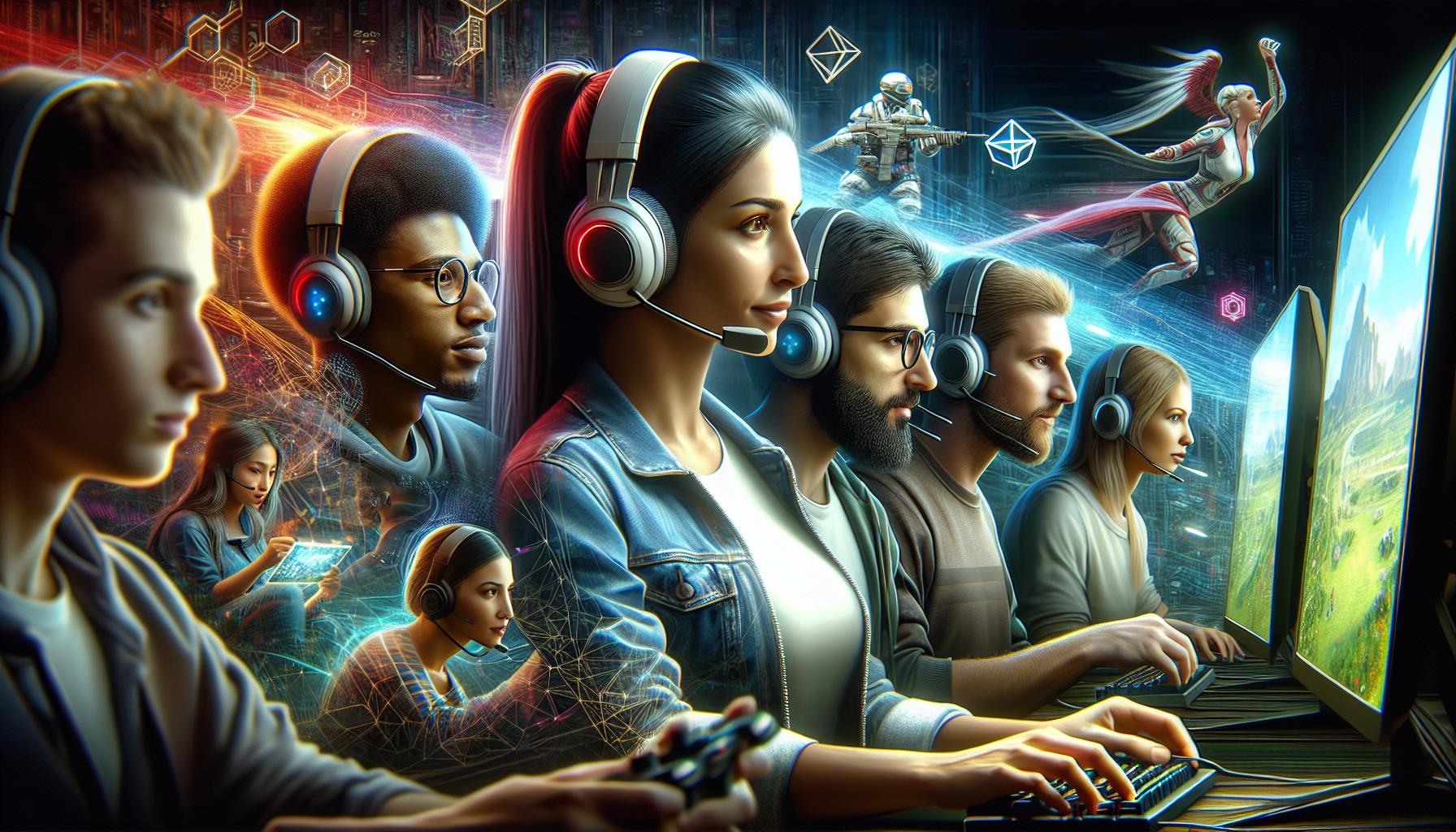As a dedicated blockchain gaming enthusiast, I’ve witnessed the incredible evolution of this revolutionary technology in the gaming industry. The fusion of blockchain and gaming continues to reshape how we play, earn, and interact in virtual worlds.
I’m excited to dive into the latest developments that are making waves across the blockchain gaming landscape. From groundbreaking Play-to-Earn titles to major partnerships between traditional gaming giants and blockchain platforms, the industry’s showing no signs of slowing down. The recent surge in Web3 gaming adoption and NFT integration has caught the attention of both casual gamers and serious investors looking to be part of this digital revolution.
Key Takeaways
- Blockchain gaming combines traditional video games with decentralized technology, enabling true digital asset ownership through NFTs and smart contracts
- Players can earn real-world value through Play-to-Earn (P2E) mechanics, with popular games like Axie Infinity and Illuvium leading the market in 2024
- Major developments in Q1 2024 include significant platform upgrades, new game launches, and improved infrastructure, with transaction speeds reaching 100,000 TPS
- The sector attracted $725 million in venture capital during Q1 2024, with gaming tokens showing substantial growth and market capitalization increases
- The future outlook projects growth to $65.7 billion by 2027, driven by mainstream gaming studio adoption and technological advancements in Layer-2 scaling solutions
Blockchain Gaming News
Blockchain gaming integrates decentralized blockchain technology with traditional video game mechanics, creating transparent game economies where players own their digital assets. These games operate on blockchain networks like Ethereum, Solana or Binance Smart Chain.
How Blockchain Technology Powers Gaming
Blockchain technology enhances gaming through three core components:
- Smart contracts automate in-game transactions using predefined rules without intermediaries
- Distributed ledgers record all game activities transparently on the blockchain
- Digital wallets store players’ assets including characters, items or cryptocurrency tokens
- Non-fungible tokens (NFTs) represent unique in-game items with verifiable ownership
The technology enables:
- Cross-game asset portability between compatible blockchain games
- Player-driven economies with real market values
- Decentralized governance through DAOs
- Immutable game rules stored on the blockchain
Key Benefits for Players
Players gain direct advantages in blockchain gaming:
Financial Benefits:
- True ownership of in-game assets through NFTs
- Trading items on open marketplaces
- Earning cryptocurrency rewards for gameplay
- Staking tokens for passive income
- Verifiable scarcity of digital items
- Interoperability between different games
- Direct participation in game governance
- Transparent game mechanics
| Blockchain Gaming Feature | Traditional Gaming |
|---|---|
| Player-owned assets | Company-owned assets |
| Decentralized economy | Centralized economy |
| Cross-game compatibility | Limited to single game |
| Real-world value | Virtual value only |
| Community governance | Developer control |
Latest Trends in Blockchain Gaming

The blockchain gaming landscape continues to evolve with groundbreaking innovations and market developments in 2024. These emerging trends showcase the industry’s rapid transformation and growing mainstream appeal.
Popular Play-to-Earn Games
Axie Infinity leads the Play-to-Earn (P2E) sector with 2.8 million active monthly users generating $3.6 billion in NFT trading volume. Five notable P2E games dominate the current market:
- Illuvium combines open-world exploration with auto-battler mechanics earning players ILV tokens
- Gods Unchained offers strategic card battles with tradeable NFT cards worth $74M in market volume
- The Sandbox enables virtual land ownership with 166,464 parcels valued at $1.2B total
- Splinterlands rewards daily quest completion with Dark Energy Crystals cryptocurrency
- Star Atlas delivers space exploration gameplay using ATLAS tokens for in-game transactions
- Weapon skins transform into cross-game compatible NFTs in CS:GO 2.0
- FIFA Ultimate Team cards become tradeable blockchain assets
- Minecraft servers support NFT authentication for exclusive content
- Fortnite introduces limited-edition character NFTs for battle passes
- Call of Duty implements NFT weapon blueprints across multiple titles
| Game NFT Category | Market Value | Monthly Active Users |
|---|---|---|
| In-game Items | $2.1B | 8.4M |
| Virtual Land | $1.4B | 2.1M |
| Character NFTs | $960M | 4.7M |
| Cosmetic Items | $710M | 6.2M |
Major Industry Developments

The blockchain gaming sector marks significant advancements in Q1 2024, driven by innovative game releases and platform enhancements. These developments signal a transformative period in the convergence of gaming and blockchain technology.
New Game Launches
I’m tracking several notable blockchain game launches that have reshaped the gaming landscape:
- Illuvium Zero launched its beta version on January 15, 2024, introducing strategic land management mechanics with 100,000 concurrent players in the first week
- Big Time expanded its universe with the “Eternal Paradox” update on February 2, 2024, adding 3 new dungeons and 5 rare NFT collections
- Star Atlas released its SAGE Labs module on March 1, 2024, enabling players to earn ATLAS tokens through space exploration missions
- MetalCore unveiled its combat-ready beta on March 15, 2024, featuring 25 unique mech designs and cross-chain compatibility
- Phantom Galaxies introduced its mainnet version on March 30, 2024, with 50,000 registered pilots and 10 star systems
- Immutable X rolled out its zkEVM scaling solution, increasing transaction speeds to 100,000 TPS
- Polygon Gaming Hub integrated 15 new game studios through its accelerator program in Q1 2024
- WAX Blockchain enhanced its marketplace with AI-powered trading features and reduced gas fees by 60%
- Avalanche Gamefi launched Subnet 2.0, supporting 5 concurrent gaming chains with dedicated resources
- Enjin Platform upgraded its wallet infrastructure, adding support for 8 new blockchains and instant NFT transfers
| Platform | Performance Metric | Q1 2024 Value |
|---|---|---|
| Immutable X | Daily Transactions | 2.5M |
| Polygon Gaming | Active Games | 150 |
| WAX | Monthly Trading Volume | $85M |
| Avalanche | Gaming Subnets | 12 |
| Enjin | Supported Chains | 15 |
Investment and Market Growth

Blockchain gaming continues to attract substantial capital investment and market expansion in Q1 2024. The sector demonstrates remarkable growth with increased venture capital funding and token performance metrics.
Venture Capital Activity
Major venture capital firms invested $725 million in blockchain gaming projects during Q1 2024. Notable investments include:
- Animoca Brands secured $150M for gaming infrastructure development
- Immutable raised $200M for their zkEVM scaling solution
- Polygon Gaming Hub attracted $175M from multiple investors
- Yield Guild Games obtained $100M for scholarship programs
- Dapper Labs received $100M to expand their Flow ecosystem
Key investment trends in the space include:
- Focus on infrastructure development projects
- Emphasis on cross-chain gaming platforms
- Support for gaming guilds and scholarship programs
- Investment in Layer-2 scaling solutions
- Funding for game development studios
Token Performance
Gaming tokens showed significant market movement in Q1 2024:
| Token | Market Cap | 24h Volume | Q1 Growth |
|---|---|---|---|
| AXS | $2.1B | $245M | +156% |
| SAND | $1.8B | $198M | +134% |
| MANA | $1.5B | $167M | +112% |
| IMX | $1.2B | $143M | +178% |
| GALA | $980M | $125M | +145% |
- Increased trading volume across gaming tokens
- Rising market capitalization in the gaming sector
- Strong correlation with gaming platform adoption
- Growing institutional investment in gaming tokens
- Enhanced liquidity across decentralized exchanges
Future Outlook for Blockchain Gaming
Market projections indicate blockchain gaming’s exponential growth trajectory, with the sector expected to reach $65.7 billion by 2027 at a CAGR of 68.4%. I’ve identified five key developments shaping the future of blockchain gaming:
Mainstream Integration
Major gaming studios like Ubisoft, EA Games, Square Enix are incorporating blockchain elements into their existing franchises. These partnerships create hybrid gaming experiences that combine traditional gameplay mechanics with blockchain-based asset ownership. Epic Games’ recent integration of NFT-based character skins generated $1.2 million in sales within 24 hours.
Technology Advancements
Layer-2 scaling solutions enhance blockchain gaming performance with:
- Processing speeds reaching 100,000 transactions per second
- Gas fees reduced to $0.001 per transaction
- Cross-chain interoperability between Ethereum, Solana, Polygon networks
- Advanced graphics rendering through decentralized computing networks
Emerging Game Models
New blockchain gaming paradigms include:
- AI-powered NPCs with autonomous behavior patterns
- Dynamic NFT evolution based on gameplay achievements
- Cross-game metaverse interactions
- Player-governed virtual economies with DAO structures
Investment Growth
Current investment trends reveal:
| Investor Category | 2024 Investment | Growth Rate |
|---|---|---|
| Venture Capital | $2.8B | 156% |
| Gaming Studios | $1.5B | 89% |
| Crypto Funds | $950M | 112% |
- Implementation of KYC protocols for P2E platforms
- Standardized asset classification systems
- Clear tax guidelines for gaming rewards
- Enhanced player protection measures
- Compliance with regional gaming laws
Decentralized Economies
Blockchain gaming stands at the forefront of digital entertainment evolution with its remarkable growth and innovation. I’ve witnessed firsthand how this technology revolutionizes gaming through true asset ownership decentralized economies and unprecedented player empowerment.
From the explosive success of P2E platforms to major investments from venture capitals it’s clear that blockchain gaming isn’t just a trend – it’s the future of interactive entertainment. I’m particularly excited to see how traditional gaming giants adapt these technologies and how new platforms continue to push boundaries.
The road ahead looks incredibly promising and I’ll continue tracking these developments as the industry moves toward its projected $65.7 billion market value by 2027. One thing’s certain – we’re just scratching the surface of what’s possible in this transformative space.



